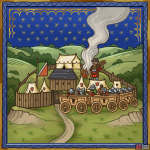Text
In the Middle Ages, various groups of soldiers, bandits, guards, or lone warriors roamed the lands, often changing their place of residence. They lived in makeshift buildings, shelters, or tents erected around a central fire. Sometimes they stayed in one camp for several days, sometimes only for one night before moving again.
Key factors for choosing a suitable campsite included access to water, food, fodder, and wood. Camps were rarely set up in villages or near castles. Only the retinues of lords and nobility stayed there. During wars or while fleeing, they camped under the open sky, as there was no time to build or dismantle a camp.
The lordly armies camped at places where the summoned national militia, reinforcements, or allies gradually gathered. The longest encampments (sometimes lasting several months) occurred during the siege of fortresses or on riverbanks, where an enemy army waited on the other side.
Tents were intentionally set up close to each other for security (like walls). The first and largest tent in the center of the camp belonged to the commander, and the tents nearby belonged to nobles and high-ranking soldiers. Simple shelters for soldiers and horses surrounded these. The army could camp separately in several locations. Larger camps often included a field chapel, a place for treating the wounded, or an improvised brothel.
Long-term camping was more challenging due to the need for supplies, which were always provided by administrators of nearby affiliated townships. If the army was on enemy territory, foraging units were sent out to find food and wood. If supplies were insufficient, they had to move or abandon the campaign.
It was difficult to maintain adequate hygiene and morale in the camp. Soldiers were threatened by epidemics, mutual quarrels, and fights. Disputes were strictly judged to maintain order.


No Comments